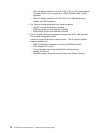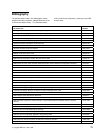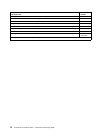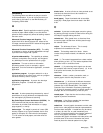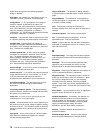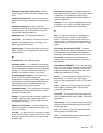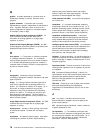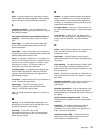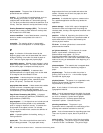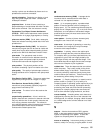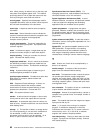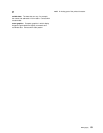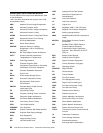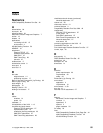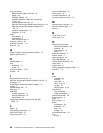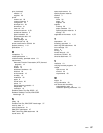output stacker. The part of the 3130 where the
printed sheets are collected.
overlay. (1) A collection of predefined data, such as
lines, shading, text, boxes, or logos, that can be
combined with variable data on a sheet while printing.
(2) The library member that contains the definition of an
overlay. See also
electronic overlay
and
forms overlay
.
Overlay Generation Language (OGL). The licensed
program that is used to create electronic overlays that
are included in the IPDS data.
overrun condition. Loss of data because a receiving
device is unable to accept data at the rate it is
transmitted.
overstrike. The merging of two or more graphic
characters in the same position on a sheet of paper.
P
page. A collection of information bound by the
beginning page control and its associated end control.
A page of printing is one side of a sheet of paper or
form. See also
logical page
and
physical page
.
page-buffer storage. Writable control storage in which
data to be printed is stored. The data is stored one line
at time until a page is complete and ready to print.
page definition (PAGEDEF). A statement that
specifies attributes of a logical page, such as the width
of its margins and the orientation of text.
page printer. A device that prints one page at a time
(for example, xerographic printer, cathode-ray-tube
printer, film printer). Contrast with
line printer
.
page-printer data stream. A data stream that enables
a printer to format a complete page at one time,
including text, images, and page segments. It is
characterized by a composed-page data-stream format.
Page Printer Formatting Aid (PPFA). A licensed
program that creates form definitions (FORMDEFs) and
page definitions (PAGEDEFs).
page segment. (1) An object that can include text and
images and that can be printed on any addressable
point on a page or electronic overlay. It assumes the
environment of the object in which it is included.
(2) The library member which contains the definition of
a page segment.
pallet. A portable platform for handling, storing, or
moving materials.
paper path. The entire route that forms travel while
they are being processed. The paper path usually
begins where the forms are loaded and ends at the
stacker. Because not all forms are paper, the term
forms path
is preferred.
parameter. A variable that is given a constant value
for a specified application and that may denote the
application.
pattern storage. In the 3130, a part of storage that
contains the fonts and images used for printing the
character data, overlays, and segments contained in the
page buffer.
partition. In Basic N_Up printing, the division of the
medium presentation space into a specified number of
equal-sized areas in a manner determined by the
current physical medium.
PC drum. A hollow cylinder that is covered with
photoconductive material.
pel (picture element). (1) An element of a raster
pattern; a point where a toned area on the
photoconductor may appear. (2) On an
all-points-addressable output medium, each pel is an
addressable unit. On a row-column addressable output
medium, the only pel addressable is the beginning of a
character cell.
photoconductor. The material that is wrapped about
the drum. The medium for transferring images to
paper.
physical page. The form on which the printer is
printing, such as an 8-1/2 x 11-inch sheet of paper.
Contrast with
logical page
.
physical planner. The person in an organization who
plans the environmental, electrical, and space
requirements for your facility.
pica. A unit of about 1/6 inch used to measure
typographical material.
pitch. A unit of measurement for the width of a printed
character. It identifies the number of graphic characters
per inch; for example, 10-pitch has ten graphic
characters per inch. Uniformly spaced fonts are
measured in pitches. Contrast with point.
planning coordinator. The person in your
organization who is responsible for coordinating all the
planning and installation activities for the 3130.
point. A unit of measurement for describing type sizes.
There are 12 points to a pica, about 72 points to an
inch.
point of origin. The location of the first print position
on a logical page. The point of origin is usually stated
in terms of X and Y coordinates. The point of origin
80 3130 Advanced Function Printer: Introduction and Planning Guide



